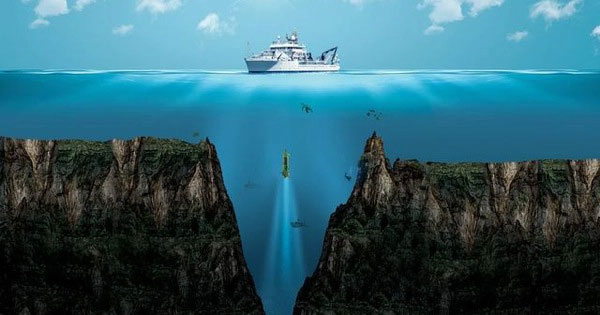How deep is the ocean?
The ocean is a vast and mysterious world with many mysteries that humans have yet to fully explore. One of the things that people are interested in is the true depth of the ocean.
Explorers began making navigational charts showing the breadth of the ocean more than 500 years ago, but it was difficult to calculate its depth.
In 1872, the British Navy's exploration ship HMS Challenger set sail to explore the ocean depths and measured one of the deepest areas, in the Pacific Ocean, the Mariana Trench.

The deepest place in the ocean known today is the Mariana Trench.
Today, scientists use SONAR — devices that emit pulses of sound energy and measure depth based on the speed at which sound travels — and measure an average ocean depth of 3.7km, but many parts are much shallower or deeper.
The deepest known place in the ocean is the Mariana Trench, located beneath the Pacific Ocean. In June 2020, scientists used the most modern deep-diving vehicle to measure the depth of this trench and determined the deepest point in an area called Challenger Deep, with the deepest observed seabed depth of 10,935m (nearly 11km).
Identifying and studying the seafloor helps us understand how the Earth works, determining how tectonic plates make up the outer layer of the planet.
When two tectonic plates move away from each other underwater, they create new ocean floor and push new layers of material from deep within the Earth to the surface. Sometimes superheated fluids from inside the Earth shoot up through cracks in the ocean floor, a phenomenon called hydrothermal vents .
In these deep regions, scientists have also found fossils of many shellfish, tube worms and other living forms. Determining the formation and tectonic processes of ocean plates, sediments accumulated on the seafloor will provide an archive of Earth's history, the evolution of species and changes in climate.
- The deepest place of the ocean
- Deep sea re-exported after 140 years
- The 10 most shocking mysteries of the ocean floor
- Detecting strange fields in the deep sea
- The fish community is forgotten in the deep sea
- Unbelievable depth of the blue sea and the truth no one expected at the bottom of the ocean
- Deep blue of sea water is a sign of death
- Amazing images of creatures deep in the ocean
- The ocean on Earth is being sucked into a place where no one knows where it is
- The mysterious 'spooky' series in the ocean
- Two more deep-sea species were discovered
- The first one to conquer the deepest point in every ocean
 Surprised: Fish that live in the dark ocean still see colors
Surprised: Fish that live in the dark ocean still see colors Japan suddenly caught the creature that caused the earthquake in the legend
Japan suddenly caught the creature that caused the earthquake in the legend A series of gray whale carcasses washed ashore on California's coast
A series of gray whale carcasses washed ashore on California's coast Compare the size of shark species in the world
Compare the size of shark species in the world